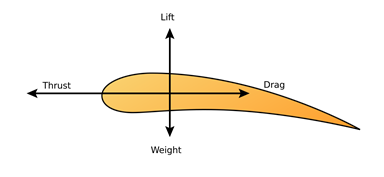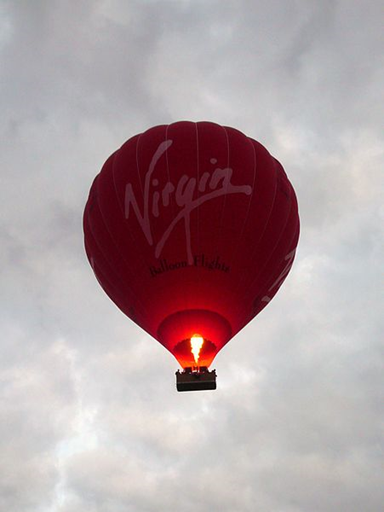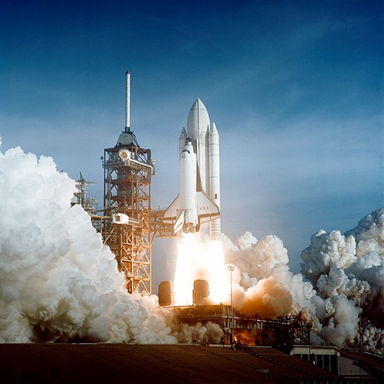The history of flight is a record how humankind defied Earth’s gravity, and more recently escaped it. Four factors have consistently been at play. Those who failed to control these have sometimes paid with their lives, or at least their aircraft.
Our understanding of flight history will be greatly enriched by understanding the dynamics of flight. We will be able to sense the particular challenges each step forward faced, and mostly conquered.
Up In the Air – The Four Factors that Affect Flight
WEIGHT – Weight is the mass of an object due to gravitational force. It directs an object in the air back down to earth, towards the center of Earth in fact.
THRUST – Thrust is the force that propels an object through the air in a particular direction
LIFT – Lift is the counter to weight that keeps an object in the air. This object can remain buoyant in the air in three ways:
o It can temporarily glide on upward currents of warm air rising
o It can rise up in the air as a hot air balloon or a gas-filled dirigible
o It can thrust forward using the air passing beneath it to fly
DRAG – Drag is the countermeasure to thrust that reduces its effectiveness, due to friction from air molecules or differences in pressure.

https://en.wikipedia.org/wiki/Thrust#/media/File:Aeroforces.svg
Rising up in the air, and remaining there is the theoretically simple matter of managing these factors to obtain the optimum mix. Therefore, in order to fly in a consistent direction at a given speed an aircraft must:
· Strike an equal balance between weight and lift
· Maintain a consistent balance between thrust and drag.
If these two relationships are not maintained, then the aircraft will increase or decrease altitude, and accelerate or slow down
Different Types of Flight Using These Dynamics
Each different class of flying object remains in the air, and moves through it by balancing those four factors of flight in a particular way.
Lighter than Air Hot Air Balloons
Hot air balloons contain heated air which is less dense than the surrounding ambient atmosphere. The functional impact depends on the temperature differential. Opening a vent at the top of the balloon releases hot air, which is displaced by ambient air entering at the bottom and allowing it to descend.

https://en.wikipedia.org/wiki/File:Virgin_Hot_Air_Balloon.jpg
Hot air balloons offset weight by increasing lift. A skilled operator can navigate to an extent by exploiting upward currents of warm air rising. However, the bulk of the balloon causes significant drag, and under windy conditions significant thrust.
Lighter than Air Aerostats

https://en.wikipedia.org/wiki/File:MarfaTX.jpg
Aerostats are lighter-than-air aircraft, defying gravity. They achieve this by filling their air chambers with lighter-than-air gas. They are functionally similar to hot air balloons with two exceptions.
· The shape is more aerodynamic allowing movement in a direction
· They may be equipped with thrust propellers promoting this movement
Unpowered Aerodynamic Flight
Unpowered aerodynamic flight, using gliders is the closest humans have come to soaring like eagles as we have dreamed. They obtain their lift from the dynamic reaction of air against their lifting surfaces. Pure gliders do not have engines. However, motor gliders have small motors to self-launch, or to sustain their flight longer.

https://en.wikipedia.org/wiki/File:Dg800.jpg
True gliders counter their weight by supporting themselves on the air through which they fly. But this is an ongoing struggle against drag, without onboard thrust to overcome it.
Powered Mechanical Flight
Powered mechanical flight uses a machine to provide sufficient thrust to overcome weight and drag, and achieve its design speed. Beyond that, the dynamic forces are similar to unpowered aerodynamic flight.

https://en.wikipedia.org/wiki/File:Forces2.gif
Powered flying machines come in a variety of designs, including airplanes, gliders, helicopters, autogiros, airships, and balloons. They obtain their airlift with different types of wings, namely tempered, semi-tempered, sweptback, rectangular and elliptical.
Space Flight
Space flight is an extreme form of ballistic flight. This is a state where there is little or no lift, and the object travels under power of momentum, gravity, air drag, and in some cases thrust.
Balls, arrows, bullets, and fireworks have been common examples of ballistic objects for centuries. Space flight is a relatively new addition; however it represents the pinnacle of humankind’s dreams to visit the stars.

https://en.wikipedia.org/wiki/File:Space_Shuttle_Columbia_launching.jpg
A spaceflight begins with a rocket launch to allow it to overcome gravity and weight, and escape Earth’s atmosphere. When the vehicle reaches space it is free from external forces of weight, thrust, lift and drag.
It may remain up there indefinitely, or disintegrate during atmospheric reentry. Or it could land on a remote comet, moon, or planet much farther away then we once dreamed possible.

Reaching for Space – The Two Factors that Affect Rocket Performance
Weight, thrust, lift, and drag progressively become less relevant as a rocket bursts free from the natural forces governing Earth:
THE ROCKET EQUATION – The mass and weight of a rocket changes as it exhausts the propellant in its propulsion system. As a result, Newton’s second law of motion no longer accurately predicts velocity and acceleration. The Rocket Equation closes the gap by enabling us to explain change in rocket momentum.
THE LINEAR AEROSPIKE – Rocket engine nozzle shape affects the behaviour of expanding gases. The linear aerospike replaces the traditional bell-shape design with a series of smaller combustion chambers to maintain more efficient thrust in decreasing atmospheric pressure.








